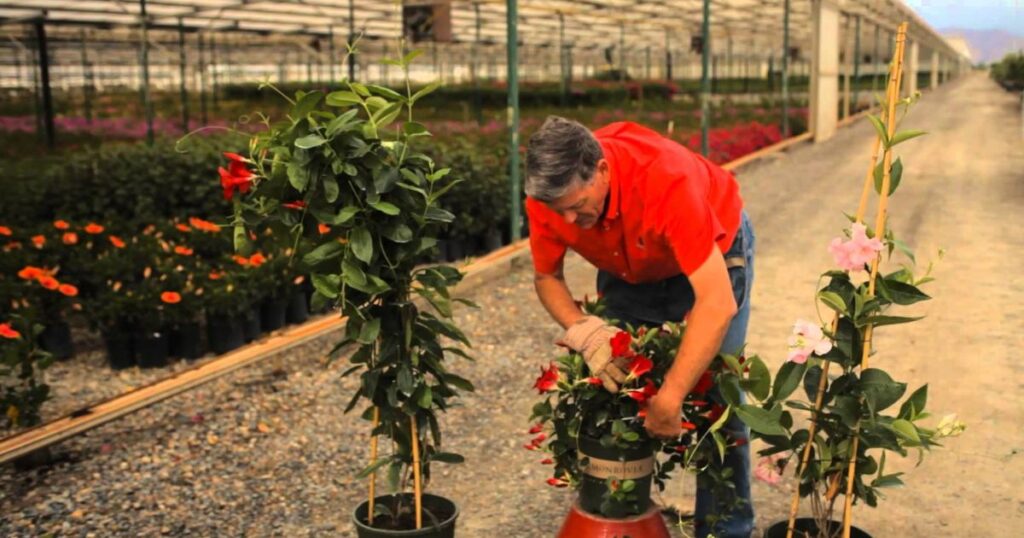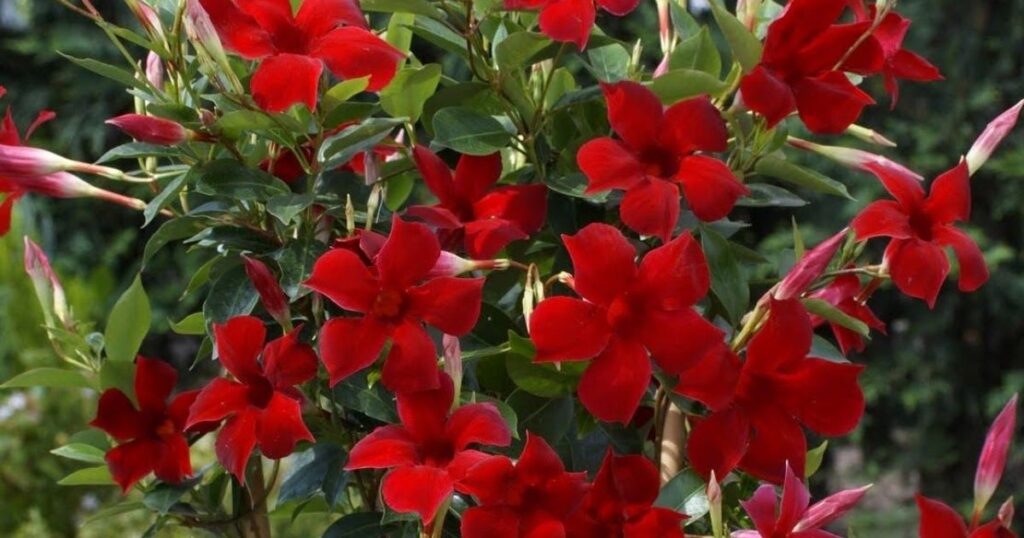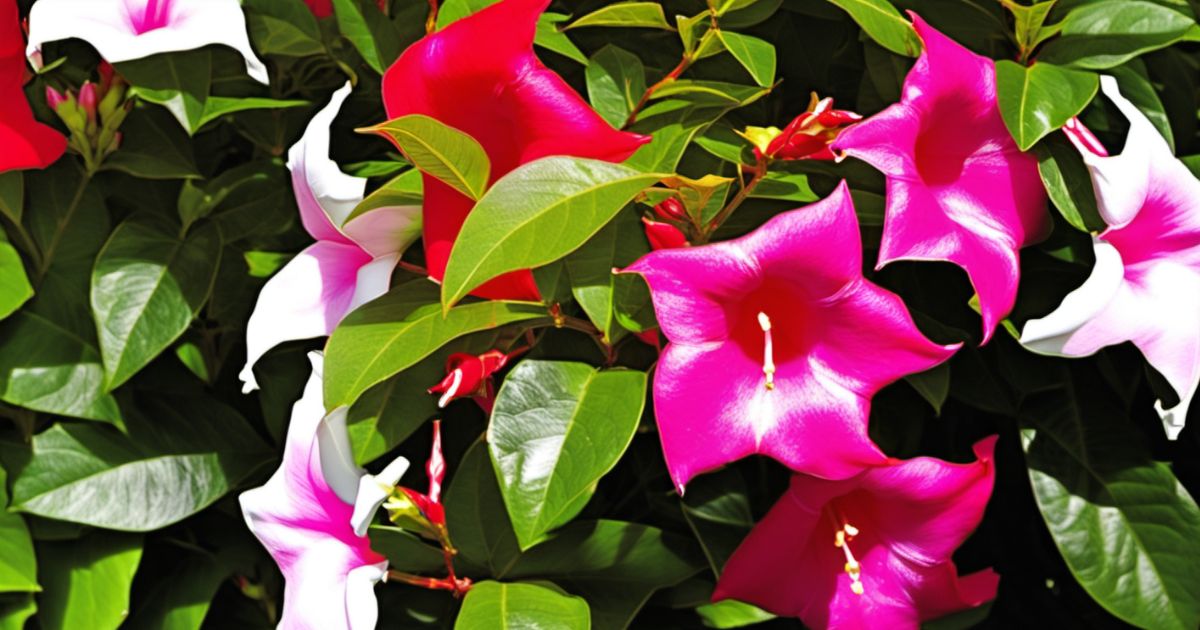With gorgeous colorful blooms and shiny green foliage, mandevilla makes a stunning tropical addition to containers and garden beds. This beginner’s guide covers everything you need to know to successfully plant, grow and care for mandevilla vines.
We’ll explore proper conditions, planting, watering, fertilizing, pruning and troubleshooting for mandevilla. Get helpful tips to maximize growth and blooms from these heat-loving tropical vines perfect for decorating vertical spaces.
Mandevilla Overview
Mandevilla comprises over 100 species of evergreen flowering tropical vines in the dogbane family Apocynaceae. These fast-growing climbers generate abundant blooms May through October in USDA zones 9-11 or as houseplants.
Popular mandevilla cultivars were bred from two species – Dipladenia and M. boliviensis. Growth habits range from vining to bushy with some varieties reaching up to 20 feet long. Give mandevillas climbing support to showcase abundant bell-shaped flowers in eye-catching colors.
Where to Plant Mandevilla
Mandevillas need warm conditions between 65-85 Fahrenheit ideally with high humidity. They flourish outdoors in zones 9-11 or container grown where they can be moved indoors during cooler months.
Plant in fertile, well-draining soil amended with compost. Choose a bright sunny location with support for climbing growth. Mandevillas make beautiful container plants for patios, trellises, hanging baskets, and garden fences or arbors.
How and When to Plant Mandevilla

Plant named mandevilla cultivars from nursery seedlings or container plants after all danger of frost passes, usually after the last spring frost date for your region.
Dig a hole twice as wide as the root ball of young plants. Set the root crown slightly above ground level to prevent rotting. Backfill soil firmly and water thoroughly after planting.
Start mandevilla from seed indoors 8-10 weeks before the final frost date. Sow seeds 1⁄4 inch deep and maintain 70 Fahrenheit heat until germination. Transplant seedlings after developing 2-4 true leaves. Harden off gradually before transplanting outdoors.
Read this Post for more information : Oldest, Tallest, and Biggest Trees
Mandevilla Care Tips
Caring properly for mandevilla vines promotes vigorous growth and prolific blooming during the warm season. Provide suitable conditions and consistent care to maximize their spectacular floral displays.
Light
Mandevillas thrive best in full sun exposures. Give them at least 6 hours of direct hot sunlight daily for heaviest blooming. A little afternoon shade prevents leaf scorch in intense southern sun. Insufficient light results in sparse weak growth with few flowers.
Soil and Water
Mandevilla prefers consistently moist, well-drained soil during the growing season. Allow soil to partially dry out between waterings without prolonged wilting. Improve drainage by amending soil with compost, perlite or small gravel.
Apply 2-3 inches of thick mulch around plants to maintain soil moisture and suppress weeds. Drip irrigation systems provide an ideal way to water mandevilla vines consistently without wetting foliage.
Temperature and Humidity
Mandevilla needs consistent warm temperatures between 65-85 F and high humidity resembling its tropical origins. Move container plants indoors before frost. Use pebble trays for added humidity indoors. Avoid drafty locations and opening doors/windows in winter.
Insufficient warmth and humidity causes leaf and bud drop. Employ heat mats and grow lights if indoor conditions are suboptimal to support flowering during shorter winter days.
Fertilizer
Feed mandevilla weekly during the growing season using a balanced liquid fertilizer diluted to half-strength or a slow-release granular fertilizer applied at manufacturer’s recommended rate. Discontinue fertilizing after September to harden off plants.
Increase blue or pink flower hues by lowering soil pH with aluminum sulfate. For red tones, add dolomitic limestone to raise pH. Always test and amend soil pH before altering.
Pruning
Prune mandevilla vines during late winter through early spring before new growth appears. Remove dead or damaged growth first. Then cut back long vining stems by at least one half their length to encourage full bushy regrowth.
Pinch off new shoot tips during the growing season to promote branching on young plants. Remove spent blooms promptly to prolong flowering into fall. Cease pruning by September to allow wood to harden off before winter dormancy.
Potting and Repotting
If planting mandevilla in containers, use a 10-12 inch diameter pot with drainage holes filled with fertile well-draining potting mix amended with compost or worm castings. Repot in early spring as needed when roots fill containers using a 2-4 inch larger pot.
Pests and Problems

Mandevillas generally resist most pests and diseases with proper cultural care. Potential issues to watch for include:
- Mealybugs – Treat with horticultural oil or insecticidal soap sprays.
- Aphids – Knock off with strong blasts of water or apply neem oil sprays.
- Root rot – Allow soil to dry out between waterings and improve drainage.
- Powdery mildew – Increase air circulation and reduce shade. Apply sulfur fungicide sprays weekly.
How to Propagate Mandevilla
Mandevillas propagate easily from cuttings for free new plants. Take 6-8 inch tip cuttings in spring selecting healthy non-flowering new growth. Dip cut end in rooting hormone powder/gel then insert into moist potting mix.
Keep cuttings warm (70-80 F) and humidity very high until new roots establish in 4-6 weeks. Gradually acclimate rooted cuttings before transplanting into gardens after frosts pass.
Types of Mandevilla
Many lovely mandevilla hybrids and cultivars exist to suit varied growing climates and personal preferences. Here are a few top varieties to consider:
‘Alice Dupont’ mandevilla
This popular named cultivar produces abundant large white blossoms from spring through fall that open from pink-flushed buds. It grows vigorously reaching heights of 10-15 feet. Grow ‘Alice Dupont’ in zones 9-11 or as a container plant.
‘Sun Parasol Crimson’ mandevilla
‘Sun Parasol Crimson’ charms with a profusion of deep crimson blooms contrasting rich green foliage. A mounding variety reaching just 4-5 feet tall and wide, it shines in containers with support or sunny borders. This cultivar boasts better disease resistance and overwinters well indoors.
‘Red Riding Hood’ mandevilla
A cute bushy variety producing scarlet red flowers on 8-12 inch mounding plants, ‘Red Riding Hood’ thrives happily in containers or cascading from hanging baskets. It blooms heavily spring through fall and overwinters successfully indoors near bright sunny windows.
Chilean jasmine
Not a true jasmine, Chilean jasmine displays abundant clusters of bright white star-shaped blooms with a light sweet scent from midsummer onwards. Evergreen vining stems reach 15 feet long in mild zones 10-11 or indoor conditions. Chilean jasmine adapts well to containers.
‘Pink Parfait’ mandevilla
This lovely named hybrid bears fully double petalled rose pink blooms on vigorously vining 10 foot long stems. The very full flowers give it a feminine ruffled almost cabbage-like appearance. ‘Pink Parfait’ performs well in zones 9-11 or patio containers. Provide strong support for the heavy blooms.
New Mandevilla Varieties

Breeders continue expanding the palette with new mandevilla introductions in shades of burgundy, neon pink, soft yellow and red-white bicolors. Watch for exciting novel varieties like:
- Burgundy – Deep reddish purple blooms
- Neon Pink – Vibrant reddish fuchsia flowers on bushy plants
- Yellow – Buttery creamy lemon yellow blossoms
- Red and White Bicolor – Showy two-toned red/white flowers
- Giant Pink – Enormous luminous bright pink blooms
FAQ’s
When do mandevillas bloom?
Mandevillas bloom spring through fall, from May until the first frost, when grown in suitable warm conditions. They produce the most abundant flowers during peak summer heat.
Will my mandevilla come back next year?
In zones 9-11, mandevilla vines can be overwintered successfully if temperatures remain above freezing. Elsewhere, bring containers indoors before frost to overwinter near sunny windows. Prune back hard in late winter before restarting watering and fertilizing to renew growth.
Can I grow mandevilla indoors year-round?
Yes, mandevilla can be grown as a houseplant year-round. Provide lots of bright light from south-facing windows, maintain warm temperatures between 65-80 F, keep humidity very high, and continue watering and fertilizing plants on a regular schedule during winter dormancy. Varieties like ‘Red Riding Hood’ adapt especially well to indoor culture.
Final Thought
With striking colorful blooms blessing vertical spaces from spring through fall, mandevilla makes a splendid addition to warm climate gardens or container plantings. Caring properly for these heat-loving vines provides the right conditions for abundant floral displays.
Follow the tips covered in this growing guide to successfully plant mandevilla in the ground or containers. Then enjoy their tropical beauty cascading from hanging pots or climbing trellises and arbors to adorn your outdoor living spaces with vivid blossoms. The spectacular flowering and rapid growth of mandevilla vines will transform and beautify sunny vertical areas in your garden.











